Enhacing UX in Online Car Sales
Project
Buy online a used car
Role
UX Design
UI Design
Research plan
Team
Product designer
Developers
UX Writer
PM
where
smyle AutoScout24
year
2023
What's Smyle?
Smyle is changing the way customers buy cars making the search and buying process completely digital.
AutoScout24 Smyle is a product that sells used cars that meet certain quality criteria defined by Smyle and have been quality tested. These cars are available in the AutoScout24 marketplace.
Smyle service includes delivery throughout Germany, registration of the car and 12 month warranty among others. smyle cars can be ordered and after 4-8 weeks will be delivered ready to be driven.
One of the main challenges that Smyle faces is to educate customers on this new operating model and make customers trust Smyle to buy a car completely unseen.
Who are the Smyle buyers?
Car buyers are used to go from dealership to dealerships to find and see the car they’re looking for.
This is how buyers act for years. They need to be sure that that car fits to them, they want to test drive it and smell it. Usually they also bring a friend that knows about cars to have an extra reassurance.
According to an AutoScout24 user motivation research, AutoScout24 Smyle users differ from other potential car buyers due to their interests and mental models rather than budget or demographics. Smyle users value a lot some of the benefits Smyle offers like quality criteria and the sense of security that warranty and the trust in a big brand are bringing.
AutoScout24 Smyle aims to satisfy the “convenience seekers” who value time over money, minimum effort and are not price sensitive.
The research identified 4 main motives for users to be interested in the Smyle value proposition with Unlock access and Make it easy to be the biggest motives.
– Unlock access: people who struggle to find a car nearby
– Make it easy: convenience seekers who want to save time and mental load when buying a car
– Give guidance: people who have little knowledge about the car buying process
– Provide reassurance: people need to know that the process is trustworthy
Challenges
Working closely with the customer advocated department and combining an analysis of the questions people ask via the contact funnel, we identified missing knowledge on:
return option, car quality, quality of quality check, Smyle process & model as well as customers wishing to see and test drive the car.
Meanwhile our users are currently dissatisfied with car quality. Their expectation is a perfect car with almost no scratches, usage traces or other issues. The reality is different since used cars are expected to not be perfect and that leads to frustration and even more hurtful for the business – cancellations.
Around 7 – 10% of all cancellations are due to car quality problems – the fact that we promised some quality but after the quality check could not satisfy it.
Finally, we had realised via our recurring user tests that the pricing of the smyle service was not meeting the users expectations. For the first year the smyle service was for free. In many user tests, users were saying it was “too good to be true” and were being sceptical that there would be hidden costs later.
The 3 initiatives we wanted to focus on

Wished outcome
- Less questions around the operating model e.g. not asking to see the car live would mean that users have better understanding of smyle operating model.
- Less cancellations and less complaints to our customer advocates due to the vehicle condition – Customers don’t expect a perfect car but a used car with the acceptable usage traces.
- Higher NPS
- Improved unit economics as we were spending money to make investments to compensate for issues & keep customers happy.
- Improve conversion as the service prices will align with user expectations.
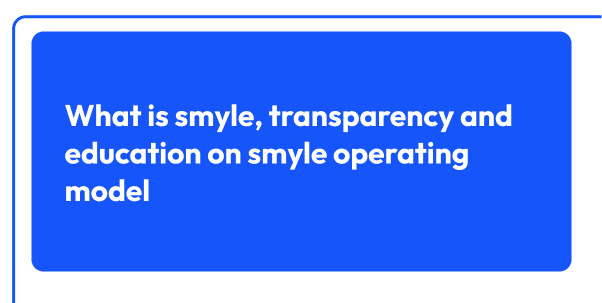
Ideas: show dealer information and role, compare how buying from dealer compares with buying with smyle, offer a “good to know” section that highlights the key differences between common car buying process and smyle buying process with a reassuring tone
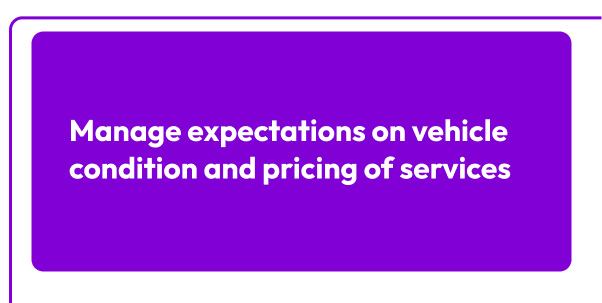
Ideas: Adding info on what to expect from used cars in basic data section (linking to usage traces modal) will manage users’ expectations regarding buying an used car. They will be aware that, even with the services/quality check, it is still an used car so they can't expect it to be 100% like a new one. We also wanted to explore monetizing the services so adding the delivery fee of €199 would give us some early signs of how users perceive now the price of the smyle service.
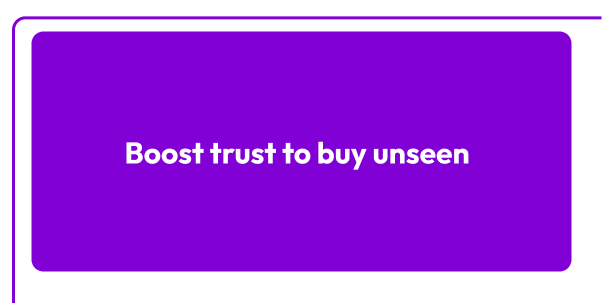
Ideas: provide vehicle reports and detailed description of smyle quality check
The best place to tackle the problems is the car detail page as it’s the one with the most traffic and where smyle users spend most of their time in comparison to other smyle pages. I did design exploration for the 3 initiatives and how they could all co-exist in the car detail page while keeping in mind the user’s main goal is to find if the car is the right one.
For the content design, I worked closely with the Lead UX Writer. We wanted to try a very direct approach on answering the most common questions.
The challenge was where to position certain content so it fits well with our users’ mental model while they browse the car detail page.
Exploring several components and visual treatments along with different positions of the presented entrypoints and content.
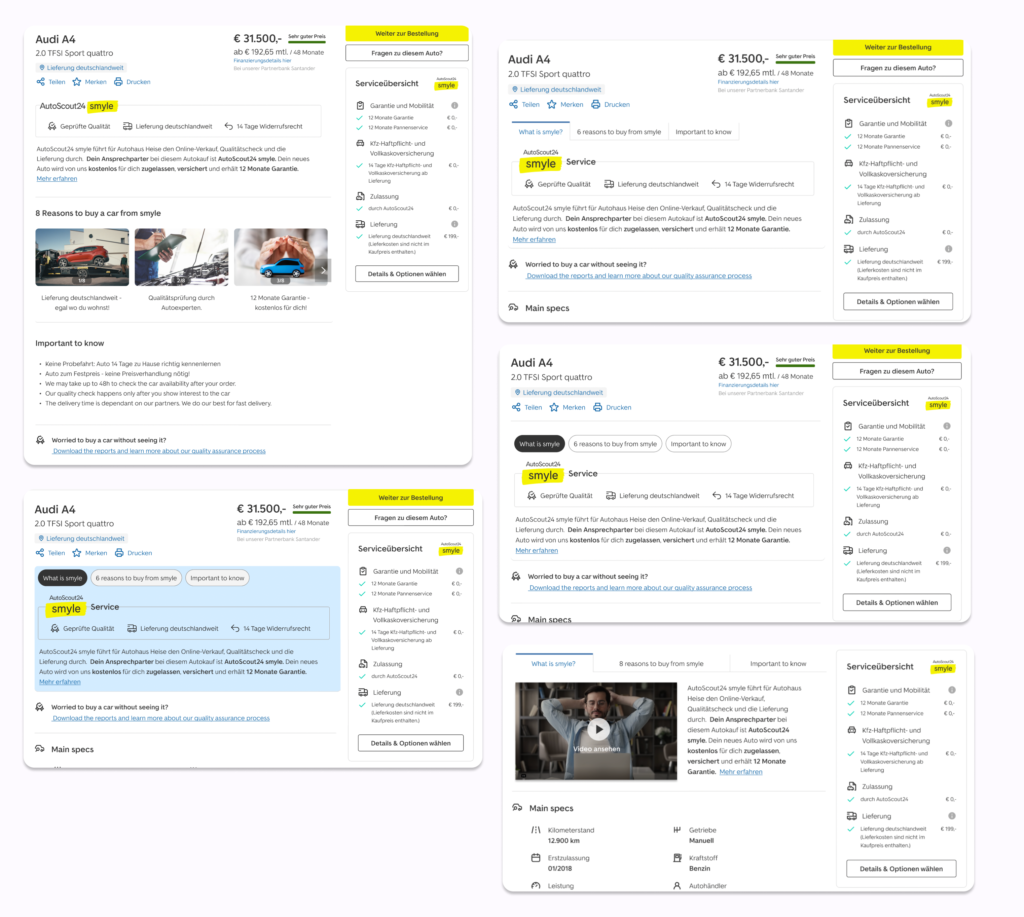
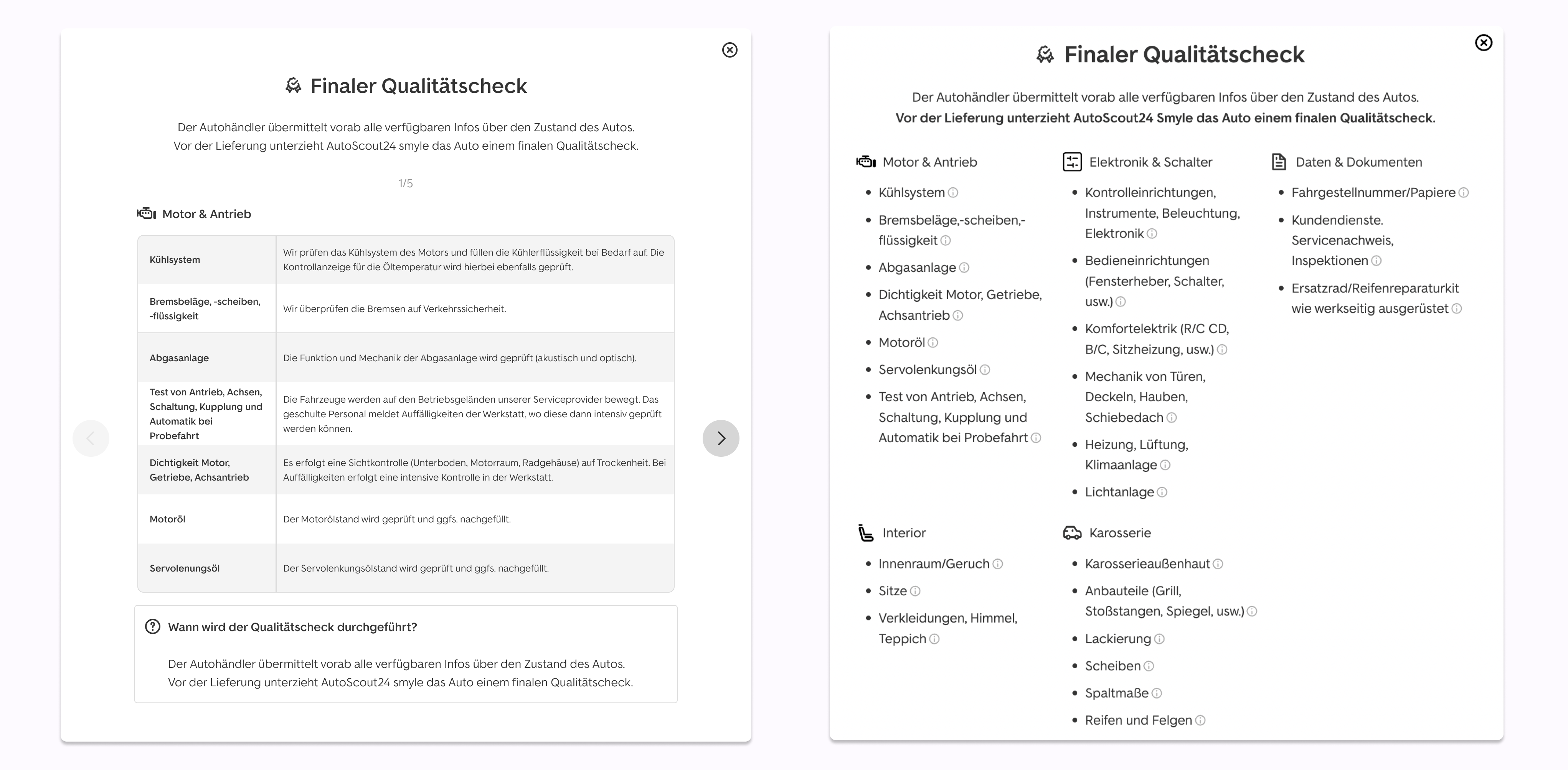
<span data-metadata=""><span data-buffer="">After a round of feedback to the initial explorations from the design team, I explored further 2 different solutions.
Doing another round of feedback with the PM and the design team I prepared two prototypes to be tested in a remote moderated usability test with 5 users.
Doing another round of feedback with the PM and the design team I prepared two prototypes to be tested in a remote moderated usability test with 5 users.
Moderated usability test with 2 interactive prototypes
The main hypotheses
- Users will engage with the "what is smyle" sections
- Users will have full understanding of smyle, smyle operating model, the good to know and the quality check process
- By adding the dealer name and mention who is the contractual partner, users will understand that the car is provided by this dealer and smyle is the contractual partner.
- By having a delivery fee of €199, the cost of the service will be closer to users expectation and they will be less sceptical.
Version 1
- Inline explanation on top of the page - First thing are the tiles - No video
- Separate links for the vehicle reports, the 25 points quality check and usage traces in the vehicle history section
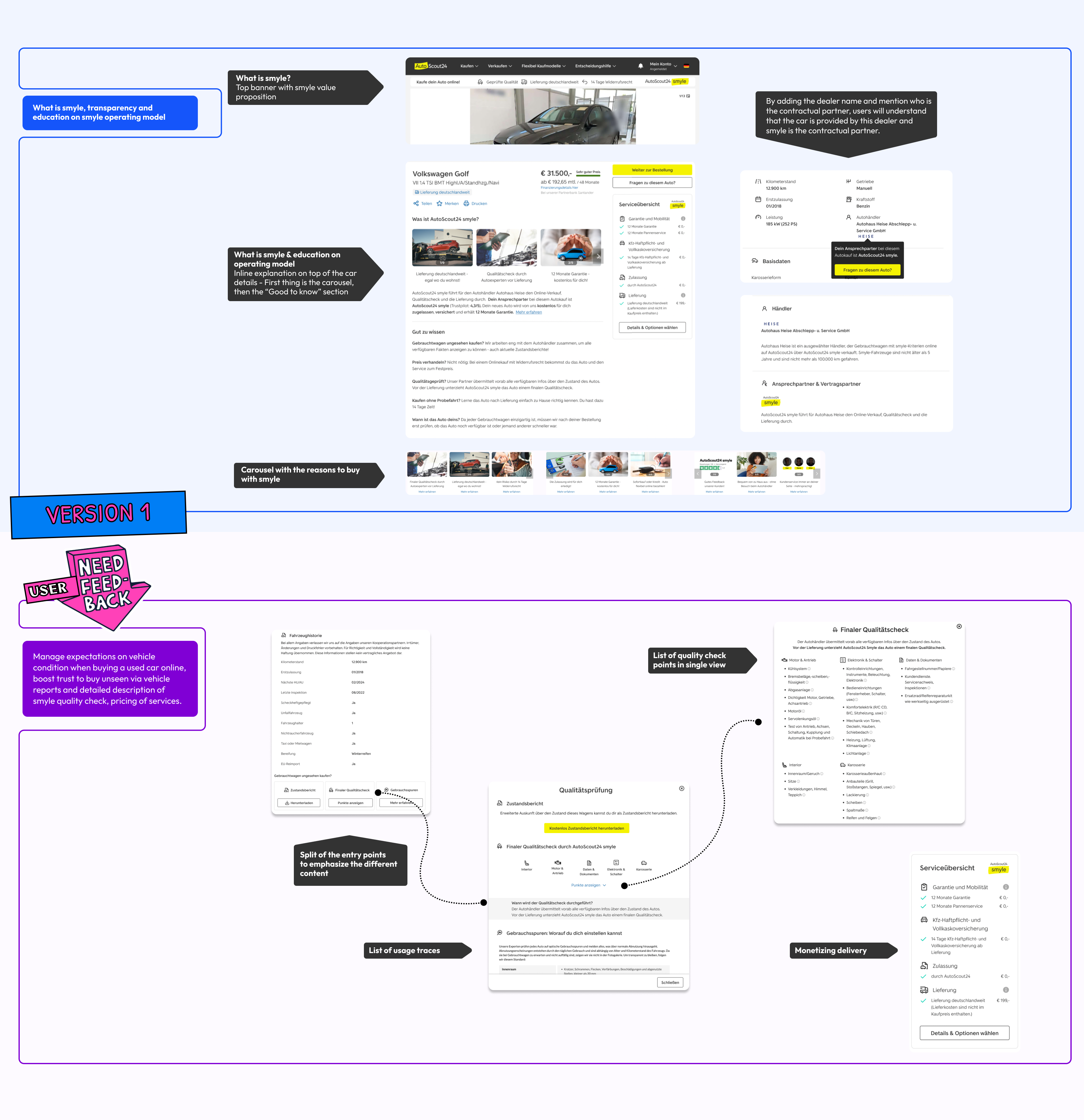
Version 2
- Tabs for explanation - First thing is the video
- One text link for all quality aspects in the vehicle history section
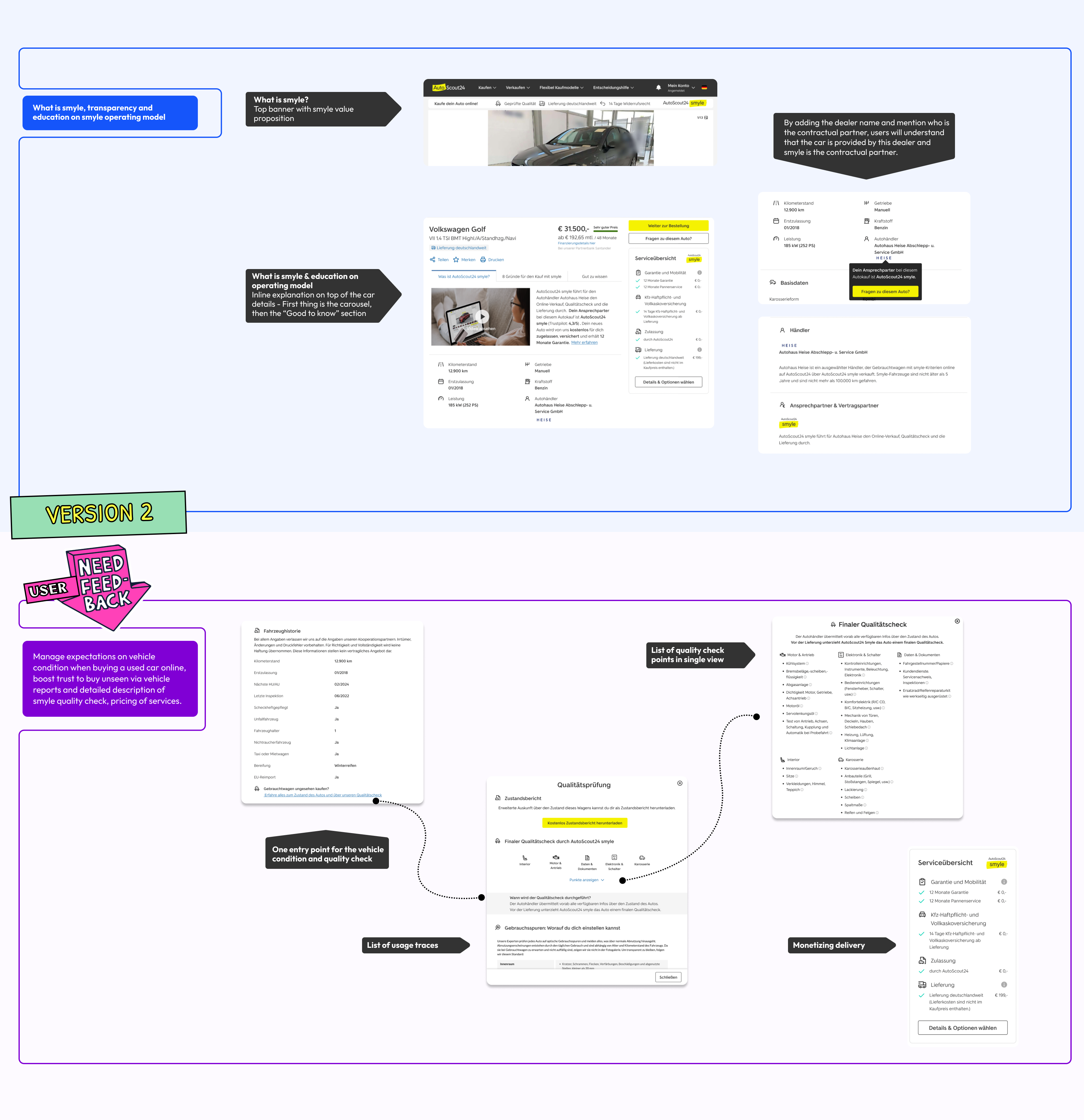
<span data-buffer="">The questions that I put together to support the UX researcher in doing the interview skeleton.
- Do buyers see and understand the smyle proposal?
- With which part (banner, first section, service box) that explains smyle are mostly engaged/gets their attention and at which point of the session in the page?
- Are there services/points of smyle that are still not clear? What questions do they have around it?
- Is the relationship with the dealers understood?
- Which components (video, slides, tabs, inline) are helpful/not helpful/engaging?
- Which version was easier to consume?
- Which version was faster to be understood?
- Which point is grabbing their attention the most? (banner, first section, service box)
- Do they understand that the quality check happens after they show interest to the car? How do they react?
High level findings
- Users skip to the car details and then return to read about smyle even if it’s higher in the page.
- The version with the tabs was more engaging than the version with all the content in line but still not engaging enough.
-
No content on the page was harmful or ‘too transparent’ and all content was useful and understandable but the position of the content needs to be defined further.
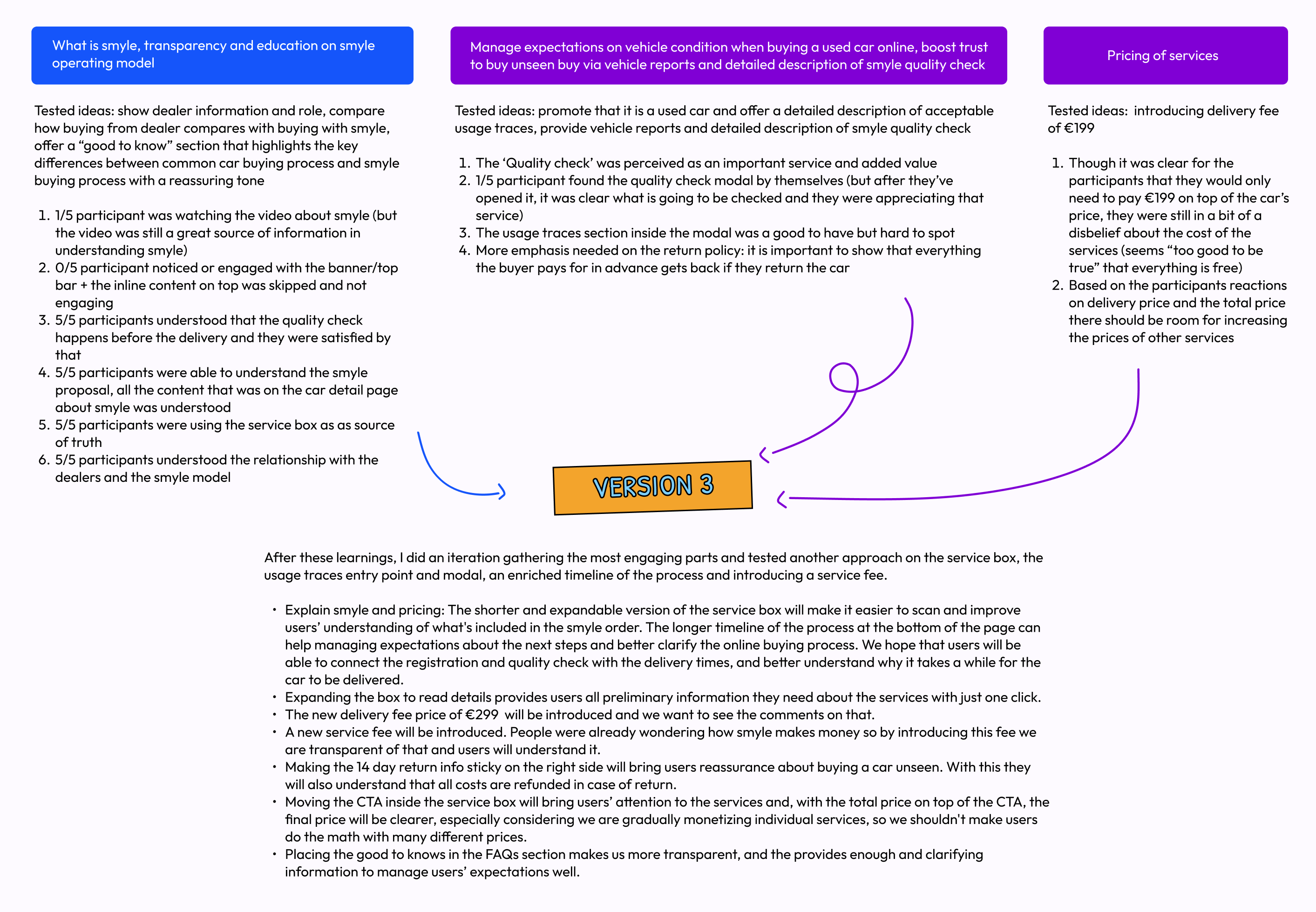
Second moderated usability test for V3 with interactive prototype
<span data-buffer="">The questions that I put together to support the UX researcher in doing the interview skeleton.
- Do they recognize that this is a smyle car by themselves?
- Do buyers see and understand the smyle proposal?
- After exploring a bit: how would the user describe what smyle is?
- Do buyers see and understand smyle proposal?
- How clear is the pricing transparency for users (car/services/total)?
- Does a shorter service box with just the checkmarks on titles make it easier to understand what’s included in a smyle order? How easy or difficult is it for users to find more details about the services if they want to?
- Can they understand what each service is about (especially Ready to drive car? What any other information about the services would they be looking for?
- Are users bothered to see just the total cost of services and having to expand the box to see the price of each service?
- Does the 14 day return and refund box increase the user’s willingness to buy unseen?
<span data-buffer="">More specifically for the quality check modal.
- Can users find entry points? Do users open it?
- How do users react to this version of this modal?
- Are they still reassured about car quality?
<span data-buffer="">More specifically for the usage traces modal.
- Do users read the information? What do they think about the copy?
- What are their expectations?
- What’s their impression?
- Are we able to manage their expectations of buying a used car with this information?
<span data-buffer="">More specifically for the entiched process timeline:
- Can users understand how it works to buy a car online with smyle?
- Do they connect the big delivery time to the services being done for them?
- Does it feel like a convenient process and give them peace of mind enough to buy online?
- What is missing? What is too much info?
<span data-buffer="">If users still have questions:<span data-buffer="">
- Can they find the Good to know section and FAQs?
- Does the Good to know section clarify their main questions about smyle?
- Would they still try to contact our customer care team?
- What info would they be looking for?
Exploring ideas for the service box.

The final version of the service box that was tested was a short version with the whole service cost so users get the overview in a glance and when they need more info they could extend it.
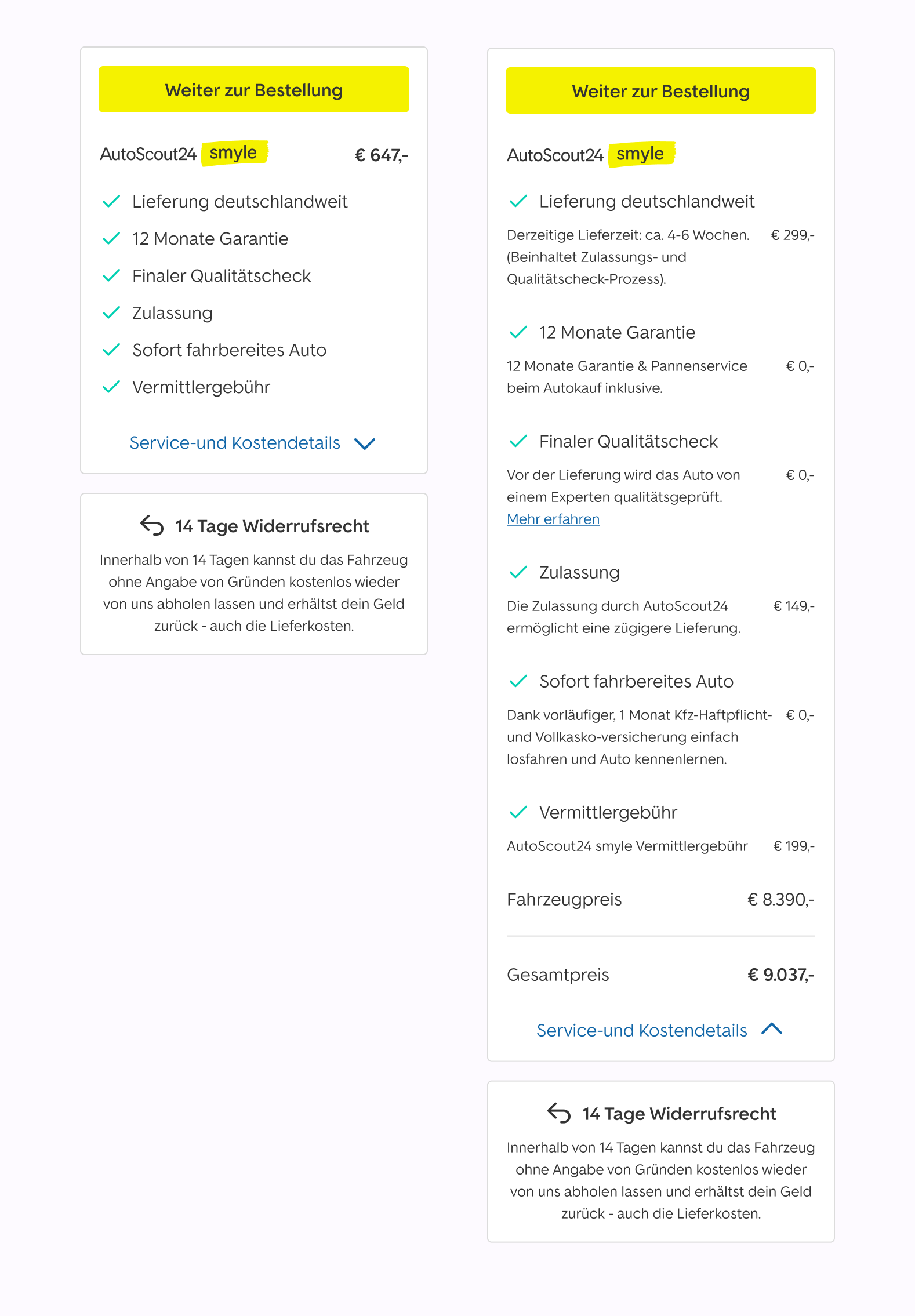
Version 3
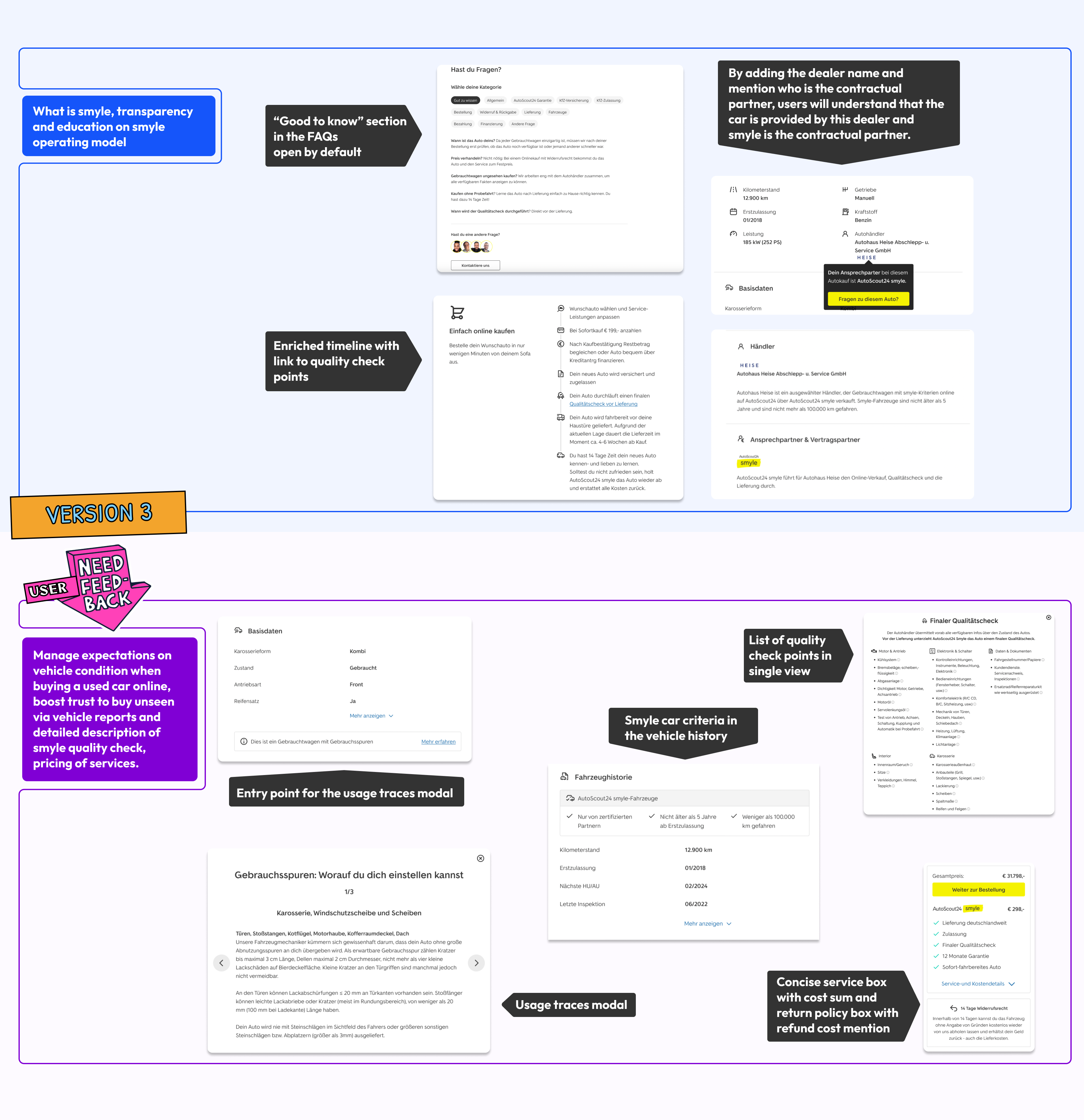
High level findings of second usability test
- The shorter service box and the enriched timeline where the source of truth for the customers and were very helpful.
- Users were able to see what’s the process and why delivery takes that long.
- They were also satisfied with the quality check points and it gave the impression of a very deep quality check.
- Finding the “Good to know” section down in the page in the FAQs was what people expected.
- The quality check as part of the service was confirmed to be considered a valuable part of the service.
- The service fee was also perceived as an expected fee that people expect in such a service.
What was implemented and the impact
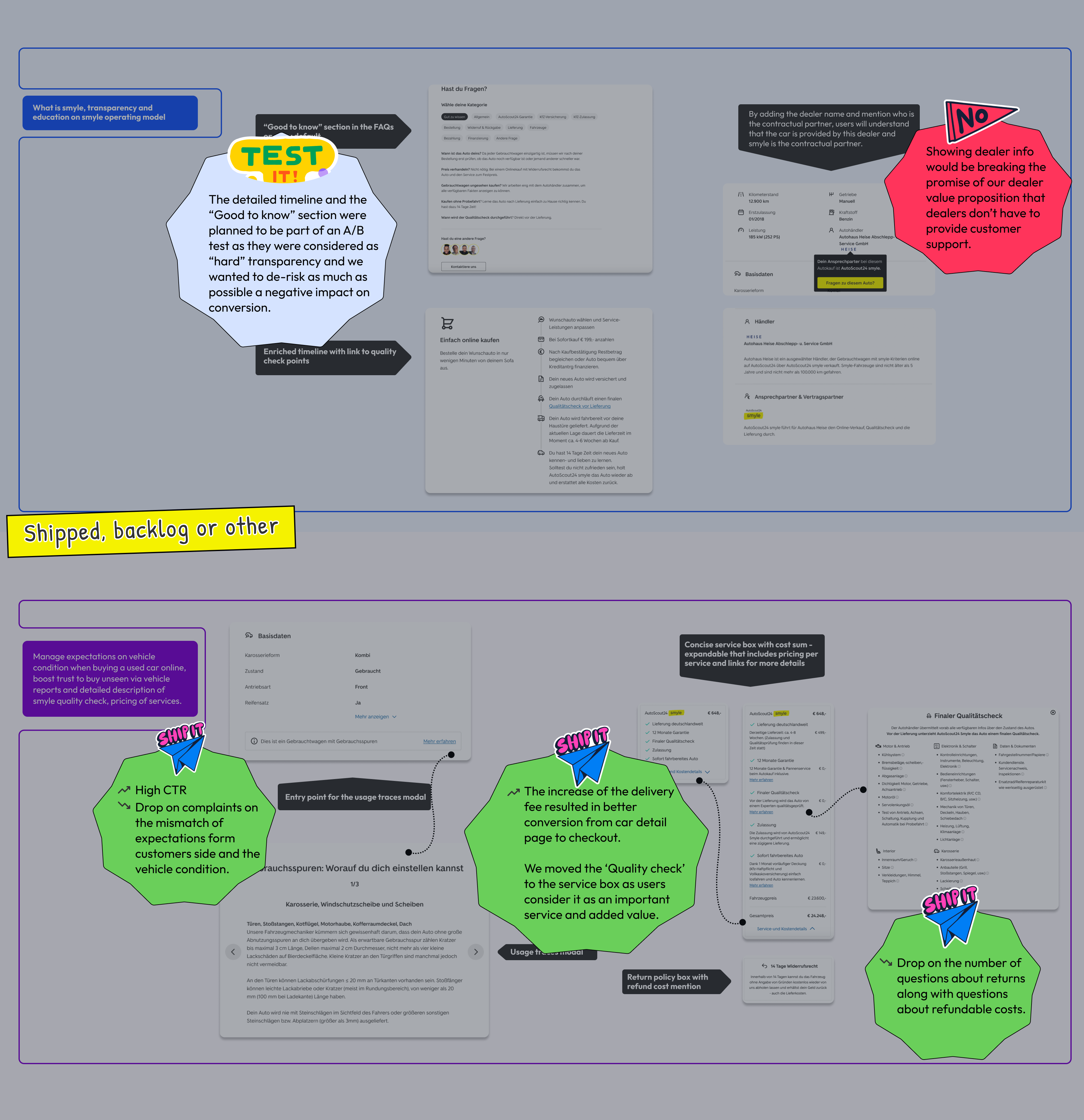

The shorter smyle service box was also implemented. The content is easier consumable, the right column is less crowded and that has an impact on the overall perception of the page. The idea to show dealer information and role was helpful for users and it was filling a knowledge gap they had, nevertheless management was afraid that users would reach out to dealers and that would be breaking the promise of our dealer value proposition that dealers don’t have to provide customer support. The idea exploration was not a waste though. It confirmed another hypothesis and idea I was exploring in parallel, which was to bring smyle as an option in the main car detail page and not have two pages for the same car. A very promising concept that was explored as another business model. The “Good to know” section and the detailed timeline were some of the engaging additions that were fulfilling the goal to boost the trust to buy unseen as well as the transparency on the operating model. They were planned to be part of an A/B test as they were considered as “hard” transparency and we wanted to de-risk as much as possible a negative impact on conversion.

The addition of the component that highlights that it is a used car and offers a detailed description of acceptable usage traces was succesfull. The click through rate of this link is satisfactory compared to other links for more info in the car detail page. The customer advocates department reported less complaints on the mismatch of expectations form customers side and the vehicle condition. The €199 delivery fee was perceived as very low pricing and led the team to start with the €299 with no harm on the conversion. The unit economics needed another boost so a variation with €499 delivery fee was tested. We already had good signals from the user tests that an overall sum of around €600 reasonates with users for the whole cost of the service. The increase of the delivery fee resulted in better conversion from car detail page to checkout. That opens a road to test more buyer’s fees that have a positive impact to conversion.

We moved the ‘Quality check" to the service box as users consider it as an important service and added value. We offer a link to enter to the detailed description of smyle quality check. The 14 days return policy was also implemented and the number of questions about returns along with questions about refundable costs dropped. Getting vehicle reports for each car in advance was an initiative that it was not possible to be completed due to high cost in getting these info for each car before having a closed sale.
Designed & built by kerry.gr
